By Randy Wells
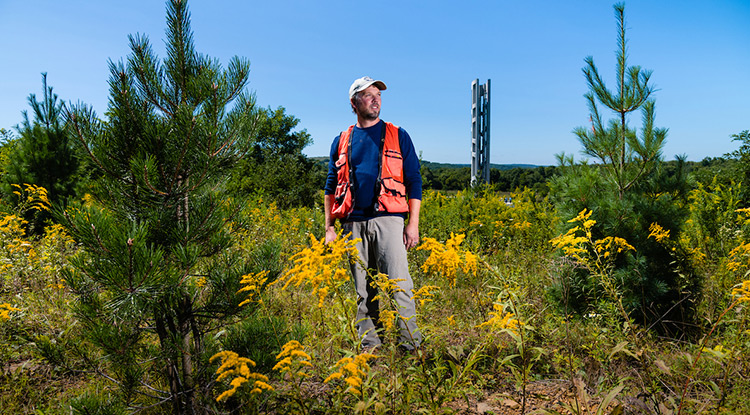
Biology faculty member Michael Tyree stands among trees planted in 2014 in a reforestation effort around the Flight 93 National Memorial. Behind him is the Tower of Voices, a musical instrument standing 93 feet tall and holding 40 wind chimes, which represent the 40 passengers and crew members killed in the Shanksville crash on September 11, 2001.
More than 20 years ago, a large tract of rural land near Shanksville, in Somerset County, could have best been described as bleak, desolate.
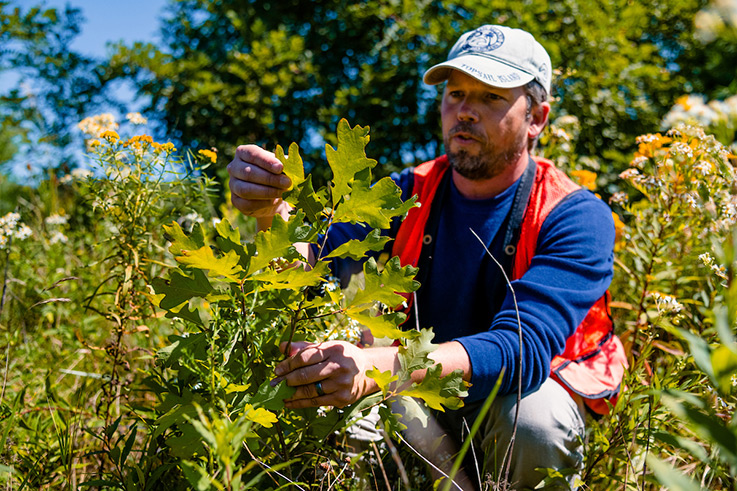
Michael Tyree checks the health of a white oak planted in 2014 as part of a reforestation effort around the Flight 93 memorial.
More about Michael Tyree
PhD, Forestry with physiological ecology focus, Virginia Tech
MS, Forestry, Virginia Tech
BS, Forest Science, Penn State University
Courses He Teaches (Selection)
BIOL 201 Principles of Ecology and Evolution
BIOL 210 Plant Biology
BIOL 481/681 Restoration Ecology
BIOL 471/571 Dendrology
It likely would have remained unremarkable and unnoticed had it not been for the events of September 11, 2001.
At 10:03 that morning, United Airlines Flight 93, headed from New Jersey to San Francisco, crashed into that rural field, killing seven crew members, 33 passengers, and four al-Qaida terrorists who had taken control of the Boeing 757. Flight 93 was one of four commercial airliners commandeered and turned into weapons that day, bringing large-scale terrorism to American soil.
Two of the airliners crashed into the World Trade Center in New York City, and the other flew into the Pentagon in Arlington, Virginia. The hijackers steered Flight 93 toward Washington, DC, and investigators believe their intended target was the US Capitol, 18 minutes flying time from Shanksville.
For several years, a small group of IUP faculty members and students have worked on a reforestation effort at the memorial.
As the unarmed crew and passengers of Flight 93 attempted to thwart the hijackers, the plane plummeted and crashed. The courage and resolve of the passengers, pilots, and flight attendants are believed to have spared America’s capital from more terrorist destruction that day.
In 2002, Congress designated the crash site the Flight 93 National Memorial. Approximately 400,000 people visit the memorial annually, and that number may grow this year as Americans observe the 20th anniversary of the 9/11 attacks.
For several years, a small group of IUP faculty members and students have worked on a reforestation effort at the memorial. The crash of Flight 93—though horrific in terms of lives lost—caused little physical damage to the already bleak and empty landscape. The real disruption had occurred earlier, from nearly 40 years of surface and deep coal mining.
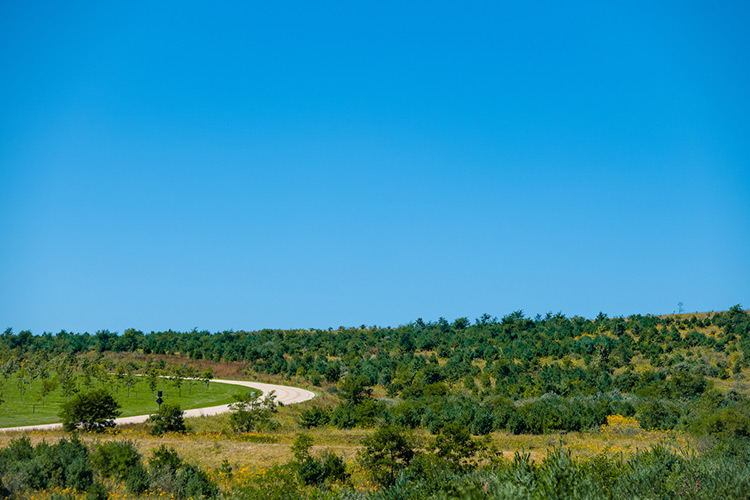
This plot shows the oldest trees, planted in 2012, that are part of the reforestation effort around the Flight 93 National Memorial.
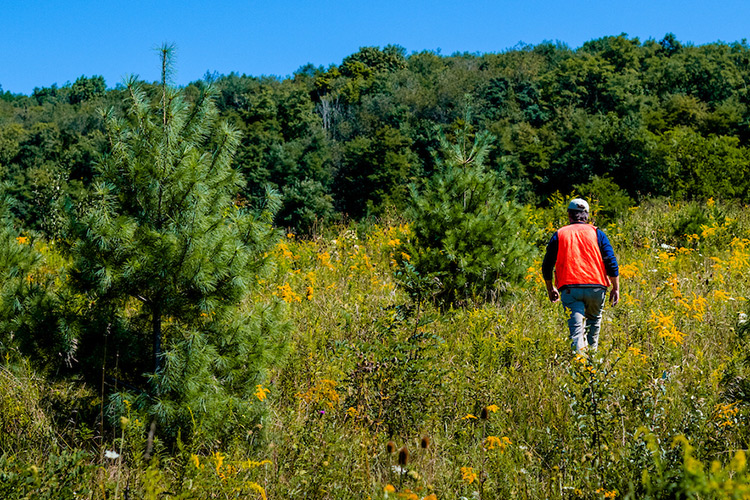
Michael Tyree walks among white pines planted in 2014 in a reforestation effort around the Flight 93 National Memorial.
Reforesting a “Model Site”
“The whole site was pretty much barren. The plane crashed on an old mine reclamation site,” said Mike Tyree, associate professor of plant ecology in the IUP Biology Department, who for the past six years has been coordinating the university’s work on the reforestation project.
In the 1990s, the site underwent traditional surface mine reclamation measures, including steps to mitigate erosion and the planting of very aggressive species of grasses that quickly covered what was then bare ground.
“This site, after 9/11, was chosen as a kind of model site, because it does have increased visibility,” Tyree said.
Nine phases of plantings since 2012 have added about 120,000 trees to more than 100 acres around the memorial. The 10th planting phase is scheduled for April 2022.
The memorial site encompasses 2,200 acres. The core of the formal memorial—which includes a visitors’ center, the Memorial Plaza, the Wall of Names, and a 1.25-mile circular walkway—will remain a natural prairie, with native and non-native grasses and wildflowers. But the area just outside the formal memorial is gradually being planted with young trees.
“The ultimate goal is to reforest it and get it back to what it would have been like,” Tyree said. “And that fits in well with an approach being done by the Appalachian Regional Reforestation Initiative to reforest these old surface mines back to what they were prior to mining, trying to get a species composition mix that is similar to what was there.”
Students on the Reforesting:
“An Emotional Thing”
On the morning of September 11, 2001, IUP professor Mike Tyree was an undergrad forestry major at Penn State University. He was taking a coffee break with friends between classes when they heard the news about a plane hitting the World Trade Center in New York.
“There weren’t a lot of details” at first, he said. “In my mind, I thought it was more like a crop duster, a little plane. Then the second plane hit, and they shut down campus and sent everybody home. At that point, they really didn’t know what was happening. Then, like everybody, we were watching it on TV.”
Tyree did his graduate work at Virginia Tech and began his teaching career in Louisiana before joining the IUP faculty. He first visited the Flight 93 crash site in 2015, when some of the memorial’s features were still under construction.
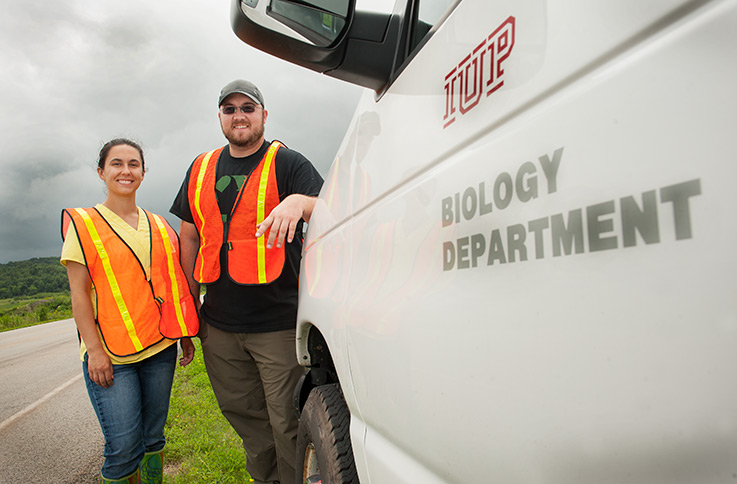
Cassandra Krul ’15 and Ian Forte ’15 helped with the Flight 93 memorial reforestation project in 2015.
Four phases of plantings had been completed at the memorial when Cassandra Krul, then an IUP biology major from Cranberry Township, began helping with the planting. She later returned as a reforestation technician to help monitor the health and growth of the saplings.
“We created GIS [geographic information systems] maps and chose 30 points on each plot,” she said. Then, she and the others walked among the trees, checking on the success of various species and for evidence of insect infestation.
“It was very eye-opening. It was a great experience,” she said. She also enjoyed hearing stories about what had happened at the site and working with National Park Service personnel. After graduating in December 2015, she helped at the memorial again while serving with AmeriCorps.
“I was so young” on the day of the 9/11 attacks, she said, but she recalls frightened parents coming to her elementary school and taking some of her classmates home early.
Now a program analyst for the Environmental Protection Agency in Kansas City, Krul hopes one day to visit the Flight 93 memorial with her grandchildren.
“Absolutely, in 20 or 30 years, and tell them I was part of the project that helped put these trees here,” she said.
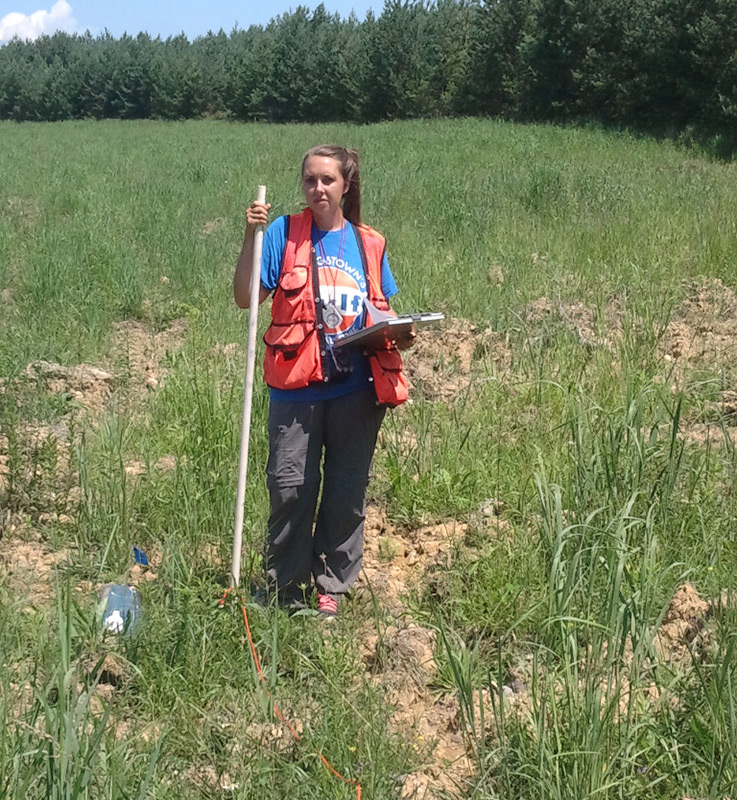
Shannon Johns Pierce ’17 was at work at the Flight 93 memorial site in 2017.
Shannon Johns Pierce, of Vintondale, was eight years old when the terrorists attacked America on 9/11.
“I remember it like it was yesterday,” she said. “My parents came and got me at school” after news of the plane crashes spread. Other fearful parents took home many of her classmates, too.
At IUP years later, her involvement in the reforestation project at the memorial site came about differently than it did for biology majors.
Pierce was a geography major with a minor in biology. “I did a lot of GIS work,” and that skill was useful in creating records of where certain species of trees are located at the memorial, she said.
Pierce worked on the reforestation project the spring and summer before she graduated in December 2017, and she, too, returned to help at the memorial during a one-year tour with AmeriCorps. She is now employed with the Cambria County Conservation District.
“It was a strange feeling” to be at a location where so many had died tragically, she said. “I enjoyed the work we did, but it was hard—an emotional thing, which added a different layer” to her experiences there.
It was not just about science and biology, she said, but also about history and patriotism.
Many Hands in the Planting
Nine phases of plantings since 2012 have added about 120,000 trees to more than 100 acres around the memorial. Saplings ranging in height from a few inches to a couple of feet were donated by nurseries and volunteer organizations. The 10th planting phase is scheduled for April 2022, with a mix of 34 species of shrubs and trees.
“You see a lot of white pine out there,” along with oak, locust, and aspen trees, Tyree said. And the American Chestnut Foundation donated about 6,000 seedlings of that species, decimated by a fungal blight in the mid-1900s.
“In fact, this is the largest single planting of chestnuts,” outside of orchards, in the United States, Tyree said. “It’s where two restoration stories converge. Each has its own history.”
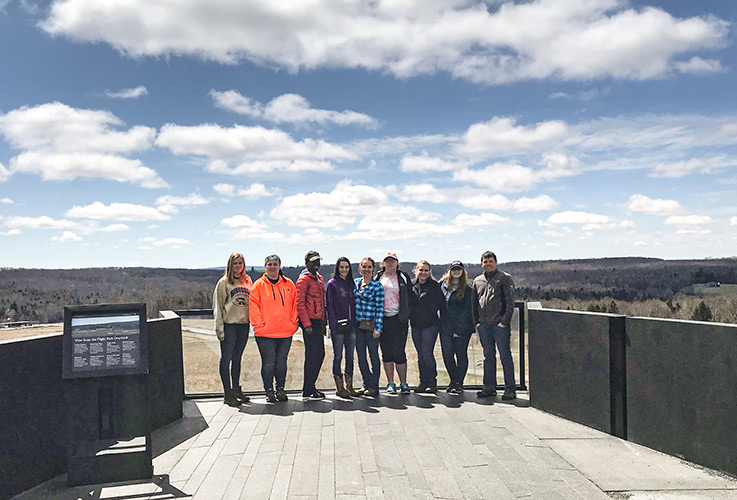
IUP participants in the Flight 93 memorial reforestation project from 2018 posed for a photo at the memorial.
Biology professor Jeff Larkin and IUP students, most of them biology majors, were among the early volunteers who assisted in planting the seedlings. Later, Tyree and students also helped create GPS records of where the chestnut trees are located. IUP’s main role is to monitor the health of the trees, observing growth and survival rates by species and the impact white-tailed deer have on the saplings as they emerge above the grasses and wildflowers.
The young trees face several challenges to their survival: the compacted soil of a former mine site, unfavorable weather, lack of sunshine while they are shorter than surrounding vegetation, damage from insects and wildlife, and competition for moisture and soil nutrients from the hearty wild grasses that have a 20-year head start on them.
“It’s very much an experiment in progress,” Tyree said, indicating the site is not maintained with herbicides and is not fertilized or irrigated. “The idea is to try to successfully get a forest with as few inputs as possible.”
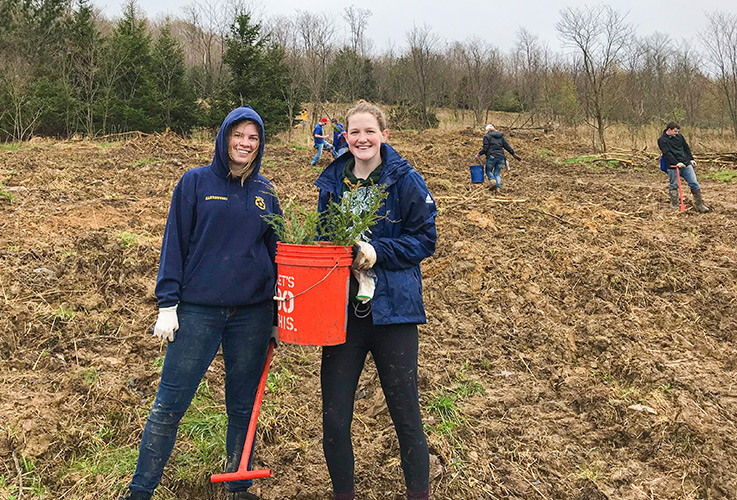
Shelby Zakrzewski M’20, left, and Kaitlin Knopsnider ’20 were members of the 2019 reforestation team.
A Teaching Laboratory
A plaque at the memorial informs visitors that the crash site is “a place of renewal. It embraces the natural environment, both stark and serene. Land scarred by decades of mining is being restored. Native trees are once again part of the landscape. ... With time, this landscape will be transformed by nature, just as this place was changed by the events of September 11, 2001.”
Tyree agrees with the symbolism of re-establishing a forest at the site.
“It’s a highly disturbed site, and putting as much of that surrounding area back to the way it was seems to make the most sense,” he said. “Most of that acreage out there is really just mine disturbance that has yet to be repaired.”
A second goal is to use the reforestation project for teaching outreach. The phases of side-by-side plantings allow educators, students, and others to observe and compare sequences of plantings where time appears to have been compressed.
“From an outreach standpoint, the site itself—minus the memorial—is very representative of the mining disturbance we see throughout a lot of Appalachia,” Tyree said. “Because it is now tied to the memorial, a very visible site, I think there is the opportunity to use it as a teaching laboratory.
“We’re happy that we can be involved, and we’re excited that we can get our students involved in some ecological restoration work,” he said. “It’s a great resource to be near.”
That work, Tyree explained, involves trying to understand what a disturbance—whether natural or man-made—will do to the landscape.
“And one application of having a foundation in disturbance ecology is restoration,” he said. “So if you understand the ecology and how disturbance impacts it, you understand there is no forest or any terrestrial system that doesn’t have some disturbance. The only thing that differs is the magnitude and the interval that it comes back. Understanding that allows you to recreate and repair some of the disturbance.”
Success Governs Future Species
Tyree said monitoring the successes and failures of the previous tree plantings at the Flight 93 memorial will guide the selection of tree species in future phases of plantings.
“From the early data, we already know what grows fast, what survives well. That goes into what the next year’s planting may look like,” he said. “That’s part of the information we want to know. We want to know what is going to be subject to disease, what’s not going to compete well, what’s going to die out, because that will help shape the way we reclaim surface mines in the future.”